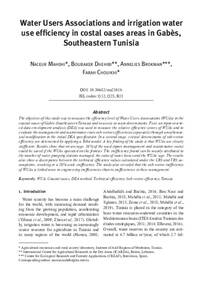Water users associations and irrigation water use efficiency in costal oases areas of Gabes, South-eastern Tunisia

Authors:
The objective of this study was to measure the efficiency level of Water Users Associations (WUAs) in the coastal oases of Gabès (South-Est of Tunisia) and assessing its main determinants. First, an input-oriented data envelopment analysis (DEA) was used to measure the relative efficiency scores of WUAs and to evaluate the management and maintenance costs sub-vectors efficiencies separately through a mathematical modification in the initial DEA specification. In a second stage, critical determinants of sub-vector efficiency are determined by applying a Tobit model. A key finding of the study is that WUAs are clearly inefficient. Results show that on average, 38% of the used inputs could be saved if the WUAs operated on the frontier. The inefficiency found can be mainly attributed to the number of water pumping stations managed, the ratio of water losses and WUAs’ age. The results also show a discrepancy between the technical efficiency values calculated under the CRS and VRS assumptions, resulting in a 20% scale inefficiency. The study also revealed that the sub-vector inefficiency of WUAs is more linked with engineering inefficiencies than to their management inefficiencies.
